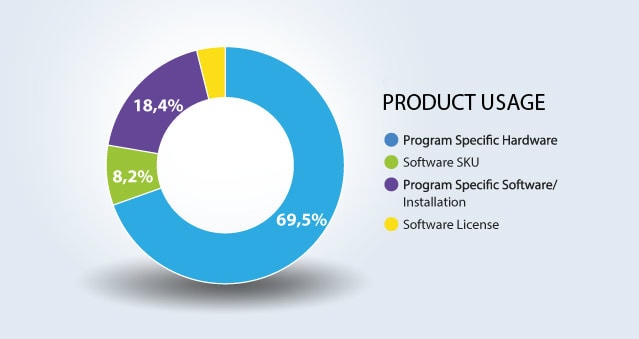With so many different billing models available, it’s not uncommon for us to hear the question: what is usage-based billing? Simply put, usage-based billing allows users to pay only for what they use – no more, no less.
Usage-based billing is certainly not a new pricing model. In fact, it’s also known as usage-based pricing, consumption-based pricing, and pay-per-use. It continues its meteoric rise among a variety of industries and verticals, including cloud-computing services, telecommunications, utilities, transportation, mobility, streaming platforms, rental services, data providers, and software-as-a-service (SaaS) organizations.
In fact, between 2018 and 2022, the number of SaaS companies adopting the usage-based pricing model grew from 27% to 46%. Add to that, 60% of companies are either fully implementing or experimenting with usage-based pricing, making usage-based billing a highly desirable pricing model. But what is usage-based billing and how does it compare with other pricing models?
Explaining: What is Usage-Based Billing?
Let’s go back to our question, what is usage-based billing exactly? Different from traditional flat-rate pricing or subscription-based billing, this pricing strategy is based on how much of the product or service a customer consumes. It aligns the value derived from your offerings with actual usage, providing customers with a level of transparency not found in other pricing models.
While at first glance usage-based billing appears straightforward, it’s not a one-size-fits-all pricing model. Let’s look at some examples of the most common usage-based pricing models.
Per-unit pricing
Sometimes called pay-as-you-go, this is the most common and simplest usage-based pricing model. It allows customers to pay for actual usage. For example, a SaaS company may charge based on the number of users or seats used, a data storage company may charge for the actual amount of storage used, and a telecom company may charge based on minutes used or data consumed.
Tiered pricing
This model is based on consumption levels, customers pay in increments depending on their usage. For instance, the first 50 GB of storage costs $0.25 per GB, however once a customer reaches the 50 GB limit, they’re charged $0.23 per GB for the next 50 GB used. At 101 GB, the customer advances to the next increment paying $0.21 per GB for up to 150 GB.
Volume pricing
While similar to tiered pricing, volume pricing has a twist. Instead of the customer paying a set incremental fee, they pay based on the highest tier reached. Let’s assume there are 3 plans for API calls, with each subsequent plans offered at a lower rate. To illustrate, the first tier offers up to 2,000 API calls per month at $0.20 per call, when a customer reaches the second tier (2,001 – 4,000 API calls per month) they will be charged $0.10 per call, and the final tier (4,000+ calls per month), is rated at $0.05 per call.
Variable pricing
A favorite among water and electricity companies, customers on variable usage-pricing plans pay based on the quantity or volume consumed.
Per feature pricing
Typically used by software companies, users pay only for the features used. For example, a customer that uses 1 feature will be charged for only that feature, whereas a customer that uses 5 features will be charged a set amount for each of the 5 features used.
Overage pricing
This pricing model requires the company to define different usage levels and rates, as well as a certain level of usage included with a per-unit price for usage over the predefined threshold. Often used by SaaS companies, customers are charged a lower rate for higher usage over a defined threshold.
Freemium pricing
With freemium pricing, the company offers a free basic version of the product or service. Then the premium features or functionality incur a fee.
Usage-Based Billing: Customer Successes
The flexibility of this pricing model makes products and services accessible to a broader audience and provides businesses with the ability to attract new customers, develop new use cases, and enhance the customer experience. Let’s look at a few companies that put usage-based pricing to the test.
AWS: A pioneer in cloud computing, AWS introduced usage-based pricing in 2006, forever changing the way businesses access and pay for computing resources. Customers pay for the resources (computing, storage, data transfers) used based on transparent per-unit rates, allowing workloads to scale exponentially – mirroring AWS’s revenue growth.
Snowflake: Known as an industry disruptor with its cloud-native platform and innovative pricing model, they became a game changer within the industry. Growing at over 100% year-over-year, Snowflake provides users with the ability to independently scale their usage and only pay for their consumption.
Zocdoc: Although valued at approximately $2B, Zocdoc’s growth had deteriorated and funds (at the rate of more than $40M per year) were rapidly being consumed. After switching from a flat fee pricing model to usage-based pricing, their provider network grew by 50%, provider churn decreased by 50%, and sales productivity increased 4 times.
While the above provides testament to the benefits of usage-based billing, there are some hurdles that need to be overcome.
Pros and Cons of Usage-Based Pricing
When done correctly, implementing usage-based pricing can have a positive impact on the way you capture value and revenue from your products and services. Here are some of the key advantages of usage-based pricing, as well as some of its inherent challenges.
Usage-Based Pricing: Advantages
- The lower barrier to adoption enables businesses to attract a broader range of customers that have different budgets and varying requirements.
- It provides usage and sales data, enabling businesses to see patterns that can be used to enhance products and services and improve sales strategies.
- By understanding how the products or services are used, businesses gain visibility in customer satisfaction, upsell/cross sell opportunities, and the ability to predict and proactively address customer churn.
- The transparency in billing provides a higher level of clarity to the billing process, which can lead to greater customer trust and brand loyalty.
- As market changes occur, companies can quickly adjust pricing based on demand, resource cost changes, or competition.
- Since customers only pay for what they use, they may decide to try new features or services, which can lead to higher consumption and increased revenue.
- Given the direct link between cost and product/service value, customer relationships are strengthened, reducing churn and improving loyalty.
- Since customers are charged based on actual usage, they are better able to manage and predict their expenses.
Usage-Based Pricing: Challenges
- Consumption data may be spread across disparate systems like CRM, ERP, and data warehouses, resulting in a variety of formats which will require significant effort to cleanse, transform, and integrate.
- Usage-based pricing can lead to fluctuations in revenue, resulting in unstable cash flow and difficulties to accurately forecast future revenue.
- The unpredictability of customer usage can lead to inefficient use of internal resources.
- Since invoices are paid in arrears, an increase in administration cost may occur.
- Customers may experience bill shock if they inadvertently use more of the product or service than intended.
While the benefits far outweigh the challenges, many of the cons can be alleviated with the right billing system and processes.
What to Consider if You’re Considering Usage-Based Pricing
With usage-based billing, customers are charged based on consumption of a product or service. To ensure accurate measures there are six components a company should consider.
1) Determine the product or service metric
This figure needs to take into consideration the value a customer derives from the product or services. For instance, a cloud storage service might use gigabytes. Alternatively, a data analytics platform may track the amount of data processed or the number of queries run. Referred to as metered billing, the metric may be:
- Clicks
- API calls
- Downloads
- Seats
- Text messages sent
- Minutes used
- Bandwidth used
- Product usage
- And more!
2) Establish pricing tiers or rates
Whether it’s a tiered pricing structure with different price points based on usage or a simpler model that uses a single rate per unit of consumption, the pricing structure needs to take into consideration your offerings, the perceived customer value, and the competition’s rates and structures.
3) Collect, cleanse, and reconcile usage data
This step must encompass all databases where information is kept to ensure accurate records of usage or events called. Referred to as mediation, this step can be complex. So it’s recommended that a mediation engine that is native to your billing system is used to ensure accuracy.
4) Track and rate usage
This is accomplished by identifying user usage, summarizing usage records, and applying the pricing plan to calculate monthly charges. Depending on the sophistication of your pricing model, the frequencies and timing of rating may vary and quickly become complex – especially if you have a large customer base.
5) Bill the customer
Typically done in arrears and at recurring intervals, the customer is invoiced for the products and/or services used. The invoices sent need to clearly detail the charges so customers can quickly associate charges with products/services used.
6) Consider your billing platform
Can your billing solution track customer usage in near or real time? Can it monitor and validate your tracking data? In the event of discrepancies, refunds, credits, promotional rates or discounts, can your billing system handle the complexities? If not, it may be time to consider a billing platform that delivers unparalleled flexibility and provides the ability to effortlessly manage complex billing scenarios, gain deeper insights into your revenue streams, and maximize your monetization potential.
Is Usage-Based Billing Right for You?
The model provides a win-win scenario for the company and customers alike. Usage-based billing offers customers a cost-effective way to use the products and services. All while providing companies with a profitable revenue stream. Although the many benefits are significant, usage-based billing isn’t designed for every company.
Now that we’ve answered, “What is usage-based billing,” here are four questions to help determine whether the pricing model is right for your company.
- Does the consumption of your products or services vary?
- Do you have the resources to manage the complex administrative needs of usage-based pricing?
- Do your costs increase the more a customer uses the product or service?
- Do customers gain increasing value the more they use the product or service?
If you answered yes to most of these questions, usage-based billing may be the right choice. Still not sure if this billing model is right for your business? Then you may want to read our white paper Usage-Based Billing – Is it Right for Your Business. It takes a deeper dive into whether your company could benefit from usage-based billing.
Stop Leaving Revenue on the Table
Regardless of the billing model you select, you need a sophisticated yet easy-to-use billing platform. One that provides support for all your business requirements – any product, any service, any business model. BillingPlatform provides the only billing solution on the market that enables businesses to support any combination of one-time charges, subscription, consumption, or hybrid-based billing – all on a single platform.
Our flexible and scalable platform puts you in control of managing and growing your revenue. We were recently named a Leader in Gartner’s Magic Quadrant for Recurring Billing Applications. They specifically highlight BillingPlatform’s strength in supporting one-time charges, fixed recurring charges, usage charges and project time, expenses and milestones. Want to see if we can help you? Our experts are ready to answer any questions you have about what usage-based billing is, so reach out today.



